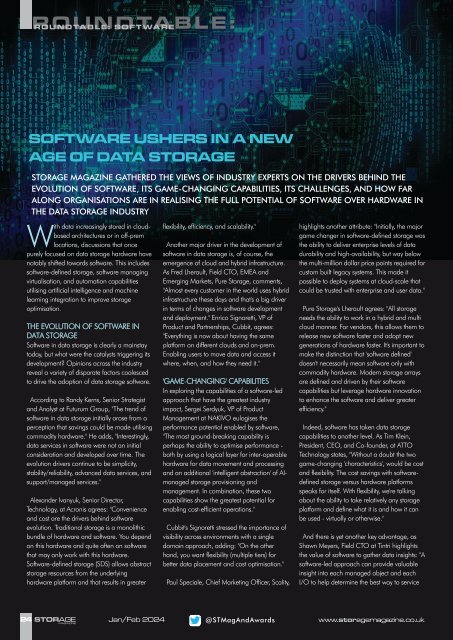ST2401
Create successful ePaper yourself
Turn your PDF publications into a flip-book with our unique Google optimized e-Paper software.
ROUNDTABLE: SOFTWARE<br />
SOFTWARE USHERS IN A NEW<br />
AGE OF DATA STORAGE<br />
STORAGE MAGAZINE GATHERED THE VIEWS OF INDUSTRY EXPERTS ON THE DRIVERS BEHIND THE<br />
EVOLUTION OF SOFTWARE, ITS GAME-CHANGING CAPABILITIES, ITS CHALLENGES, AND HOW FAR<br />
ALONG ORGANISATIONS ARE IN REALISING THE FULL POTENTIAL OF SOFTWARE OVER HARDWARE IN<br />
THE DATA STORAGE INDUSTRY<br />
With data increasingly stored in cloudbased<br />
architectures or in off-prem<br />
locations, discussions that once<br />
purely focused on data storage hardware have<br />
notably shifted towards software. This includes<br />
software-defined storage, software managing<br />
virtualisation, and automation capabilities<br />
utilising artificial intelligence and machine<br />
learning integration to improve storage<br />
optimisation.<br />
THE EVOLUTION OF SOFTWARE IN<br />
DATA STORAGE<br />
Software in data storage is clearly a mainstay<br />
today, but what were the catalysts triggering its<br />
development? Opinions across the industry<br />
reveal a variety of disparate factors coalesced<br />
to drive the adoption of data storage software.<br />
According to Randy Kerns, Senior Strategist<br />
and Analyst at Futurum Group, "The trend of<br />
software in data storage initially arose from a<br />
perception that savings could be made utilising<br />
commodity hardware." He adds, "Interestingly,<br />
data services in software were not an initial<br />
consideration and developed over time. The<br />
evolution drivers continue to be simplicity,<br />
stability/reliability, advanced data services, and<br />
support/managed services."<br />
Alexander Ivanyuk, Senior Director,<br />
Technology, at Acronis agrees: "Convenience<br />
and cost are the drivers behind software<br />
evolution. Traditional storage is a monolithic<br />
bundle of hardware and software. You depend<br />
on this hardware and quite often on software<br />
that may only work with this hardware.<br />
Software-defined storage (SDS) allows abstract<br />
storage resources from the underlying<br />
hardware platform and that results in greater<br />
flexibility, efficiency, and scalability."<br />
Another major driver in the development of<br />
software in data storage is, of course, the<br />
emergence of cloud and hybrid infrastructure.<br />
As Fred Lherault, Field CTO, EMEA and<br />
Emerging Markets, Pure Storage, comments,<br />
"Almost every customer in the world uses hybrid<br />
infrastructure these days and that's a big driver<br />
in terms of changes in software development<br />
and deployment." Enrico Signoretti, VP of<br />
Product and Partnerships, Cubbit, agrees:<br />
"Everything is now about having the same<br />
platform on different clouds and on-prem.<br />
Enabling users to move data and access it<br />
where, when, and how they need it."<br />
'GAME-CHANGING' CAPABILITIES<br />
In exploring the capabilities of a software-led<br />
approach that have the greatest industry<br />
impact, Sergei Serdyuk, VP of Product<br />
Management at NAKIVO eulogises the<br />
performance potential enabled by software,<br />
"The most ground-breaking capability is<br />
perhaps the ability to optimise performance -<br />
both by using a logical layer for inter-operable<br />
hardware for data movement and processing<br />
and an additional 'intelligent abstraction' of AImanaged<br />
storage provisioning and<br />
management. In combination, these two<br />
capabilities show the greatest potential for<br />
enabling cost-efficient operations."<br />
Cubbit's Signoretti stressed the importance of<br />
visibility across environments with a single<br />
domain approach, adding: "On the other<br />
hand, you want flexibility (multiple tiers) for<br />
better data placement and cost optimisation."<br />
Paul Speciale, Chief Marketing Officer, Scality,<br />
highlights another attribute: "Initially, the major<br />
game changer in software-defined storage was<br />
the ability to deliver enterprise levels of data<br />
durability and high-availability, but way below<br />
the multi-million dollar price points required for<br />
custom built legacy systems. This made it<br />
possible to deploy systems at cloud-scale that<br />
could be trusted with enterprise and user data."<br />
Pure Storage's Lherault agrees: "All storage<br />
needs the ability to work in a hybrid and multi<br />
cloud manner. For vendors, this allows them to<br />
release new software faster and adopt new<br />
generations of hardware faster. It's important to<br />
make the distinction that 'software defined'<br />
doesn't necessarily mean software only with<br />
commodity hardware. Modern storage arrays<br />
are defined and driven by their software<br />
capabilities but leverage hardware innovation<br />
to enhance the software and deliver greater<br />
efficiency."<br />
Indeed, software has taken data storage<br />
capabilities to another level. As Tim Klein,<br />
President, CEO, and Co-founder, at ATTO<br />
Technology states, "Without a doubt the two<br />
game-changing 'characteristics', would be cost<br />
and flexibility. The cost savings with softwaredefined<br />
storage versus hardware platforms<br />
speaks for itself. With flexibility, we're talking<br />
about the ability to take relatively any storage<br />
platform and define what it is and how it can<br />
be used - virtually or otherwise."<br />
And there is yet another key advantage, as<br />
Shawn Meyers, Field CTO at Tintri highlights<br />
the value of software to gather data insights: "A<br />
software-led approach can provide valuable<br />
insight into each managed object and each<br />
I/O to help determine the best way to service<br />
24 STORAGE Jan/Feb 2024<br />
@STMagAndAwards<br />
www.storagemagazine.co.uk<br />
MAGAZINE
















